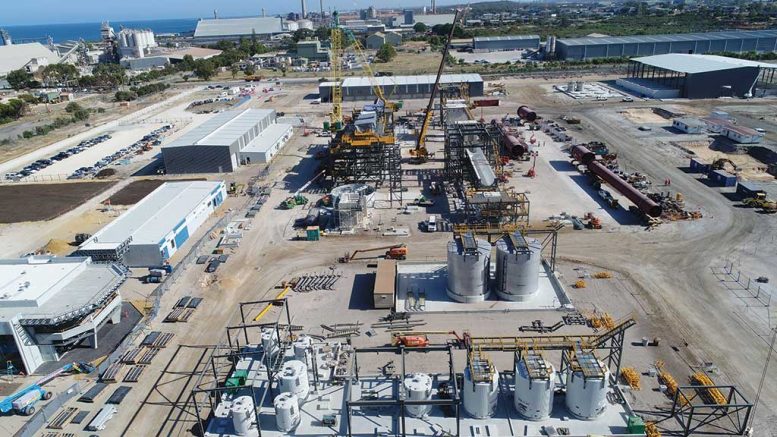Tianqi Lithium Australia, a subsidiary of China’s Tianqi Lithium, has started building a state-of-the-art spodumene converter that will produce battery-grade lithium hydroxide in Kwinana, Western Australia.
Initial production is expected by mid-2019, with sales before the end of 2019, according to a new report by Wood Mackenzie, a research and consultancy business for the global energy, chemicals, metals and mining industries.
Once in full production, Kwinana will be the largest lithium hydroxide-producing operation and the biggest converter in the world, James Whiteside, a London-based managing consultant at Wood Mackenzie and author of the report, says in an interview.
The plant will use high-grade lithium concentrate feedstock sourced from Greenbushes, the hard-rock lithium mine in southwestern Australia that Tianqi acquired in 2013–2014, and joint-ventured with Albemarle (NYSE: ALB), the mine operator.
Greenbushes’ current capacity is 80,000 tonnes of lithium carbonate equivalent (LCE), with plans to expand to 180,000 tonnes LCE in the early 2020s, Whiteside says in his research note.
The mine produces multiple spodumene concentrates and they average 6% lithium oxide. Then, at Kwinana, the concentrate will be converted to lithium hydroxide, which can be used in battery materials for the electric vehicle and energy-storage markets.
The new plant is “likely to change the cost profile for lithium conversion,” Whiteside says.
“All spodumene conversion currently happens in China, where total conversion costs are around US$6,000 per tonne for lithium hydroxide,” Whiteside says, adding that China has to import most of the spodumene it requires, which contributes to the higher cost.
At the moment, making lithium hydroxide from hard rock spodumene mines and brines is fifty-fifty, Whiteside tells The Northern Miner, but by 2025 he says two-thirds of it will come from spodumene operations.
With lithium brine operations, he says, the lithium is processed into carbonate first.
“Brine goes to carbonate and is further processed to hydroxide, whereas in spodumene processing, you can skip the carbonate phase and produce hydroxide directly.
“Total costs for producing lithium hydroxide from spodumene are around US$500 per tonne lower than for producing carbonate. Hydroxide contains less lithium than carbonate so less spodumene feedstock is required, and energy consumption at the calcination stage is lower.”

An aerial view of Tianqi Lithium and Albemarle’s Greenbushes lithium mine in southwestern Australia. Credit: Tianqi Lithium.
Having integrated and local spodumene supply from Tianqi and from projects that are expected to come on stream, such as Nemaska Lithium’s (TSX: NMX) Whabouchi spodumene mine in Quebec, will also lower the costs of inputs at both operations, he says.
Estimates are that it will cost between US$1,500 and US$2,000 per tonne to produce a tonne of lithium hydroxide at Whabouchi and Kwinana, Whiteside says, while it will cost Chinese producers US$6,000 per tonne.
“It’s a massive difference — it changes the face of the industry,” he says. “If these forecasts are proven correct, lower conversion costs at integrated producers could change the cost structure of the entire lithium-mining industry.”
More than 95% of cathode material production and manufacturing capacity is in Asia. But China has the highest-cost spodumene mines in the world, and they have to pay market prices and freight for transporting spodumene from Australia.

Tianqi Lithium’s lithium hydroxide processing plant under construction. Credit: Tianqi Lithium.
“Their lithium content isn’t anywhere like what you’d get in Australia,” Whiteside says of China’s spodumene mines, which are quite small. “At Greenbushes, head grades get up to 2% lithium oxide, which is very high,” he says. “In China, they are mining at grades of 0.4% to 0.8% lithium oxide.”
That means that battery makers could set up shop in Australia in greater numbers.
As soon as Kwinana is in production, Australia will have all the precursor materials needed to make a high-performance cathode for a lithium-ion battery — lithium hydroxide, cobalt hydroxide and nickel sulphate.
According to Whiteside, Energy Renaissance is planning a 1 GWh capacity, battery-making plant in Darwin, and Magnis Resources is considering a 15 GWh plant in Townsville.
The Greenbushes spodumene mine, is the largest active lithium mine in the world.


Be the first to comment on "Tianqi to build world’s largest spodumene converter"